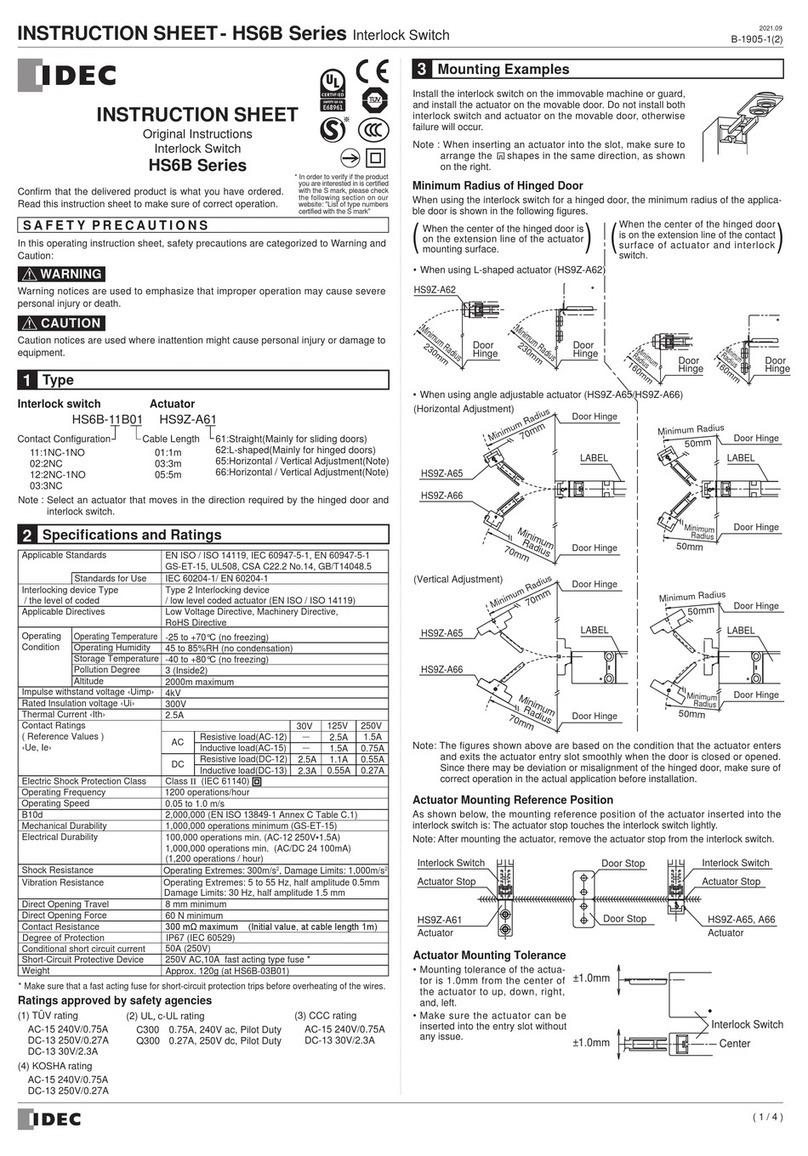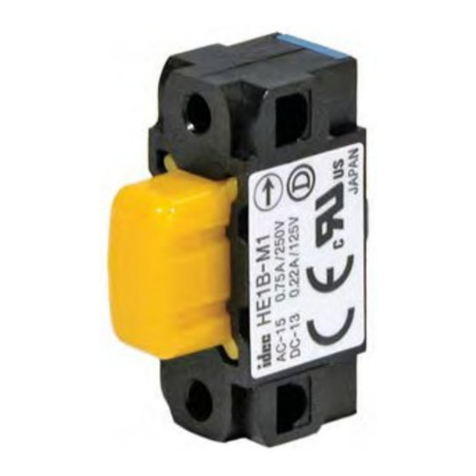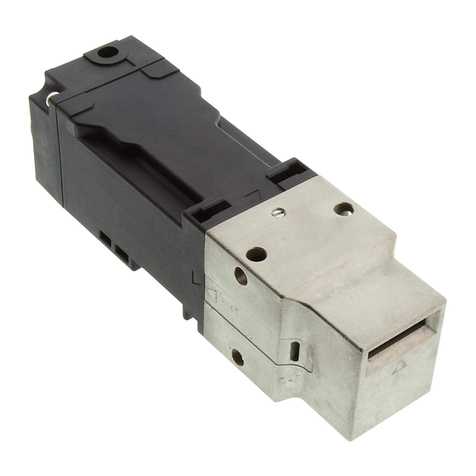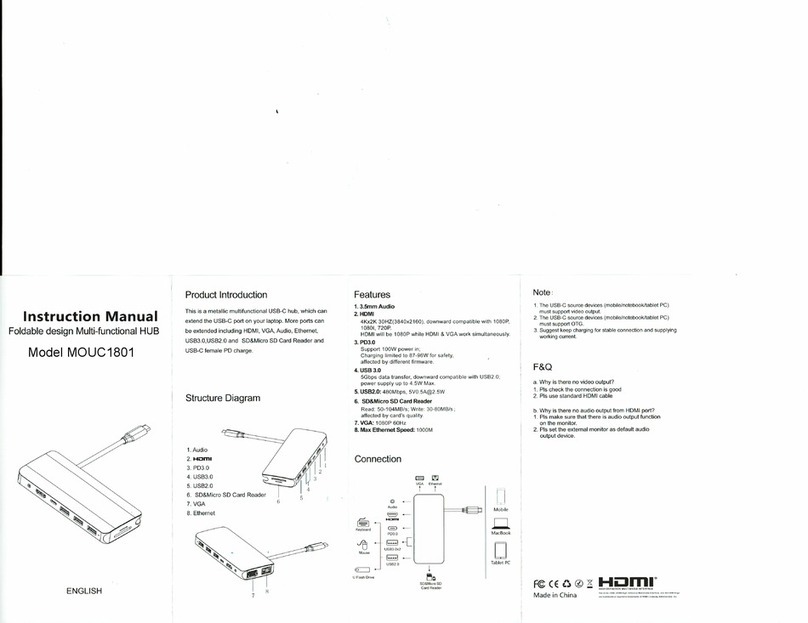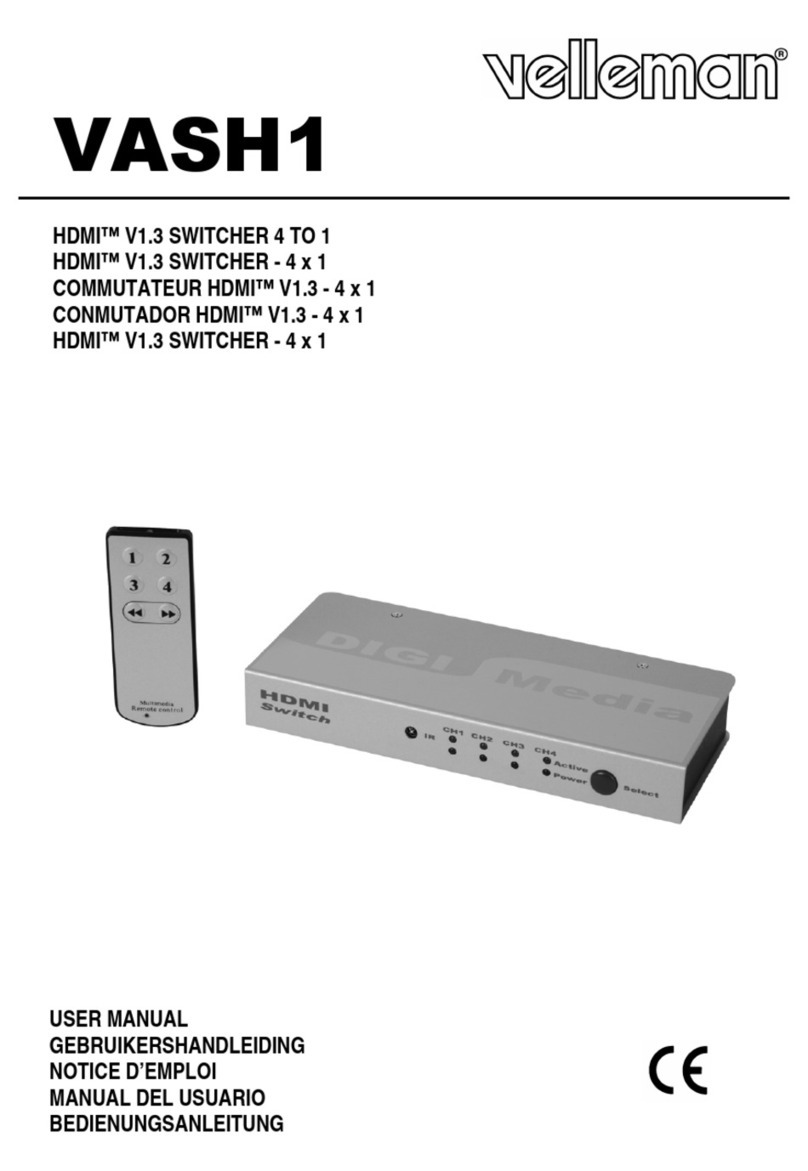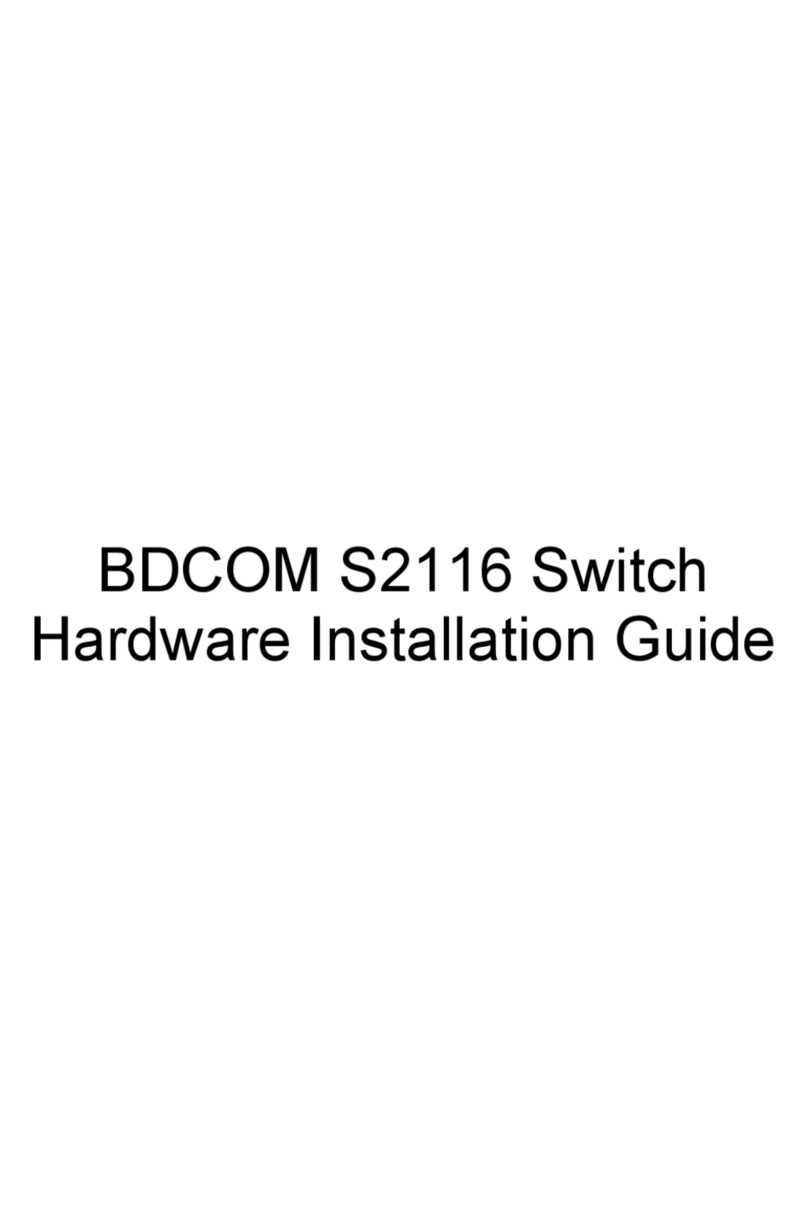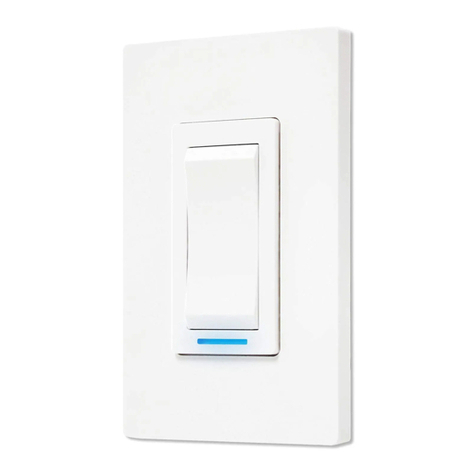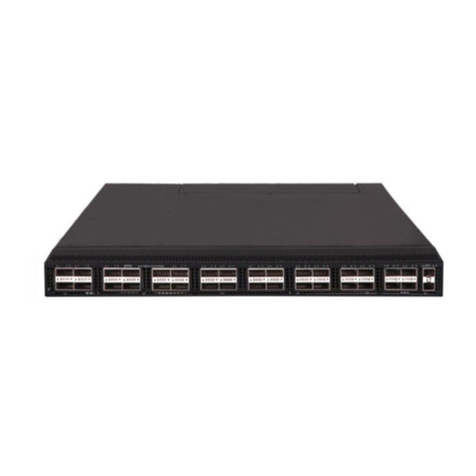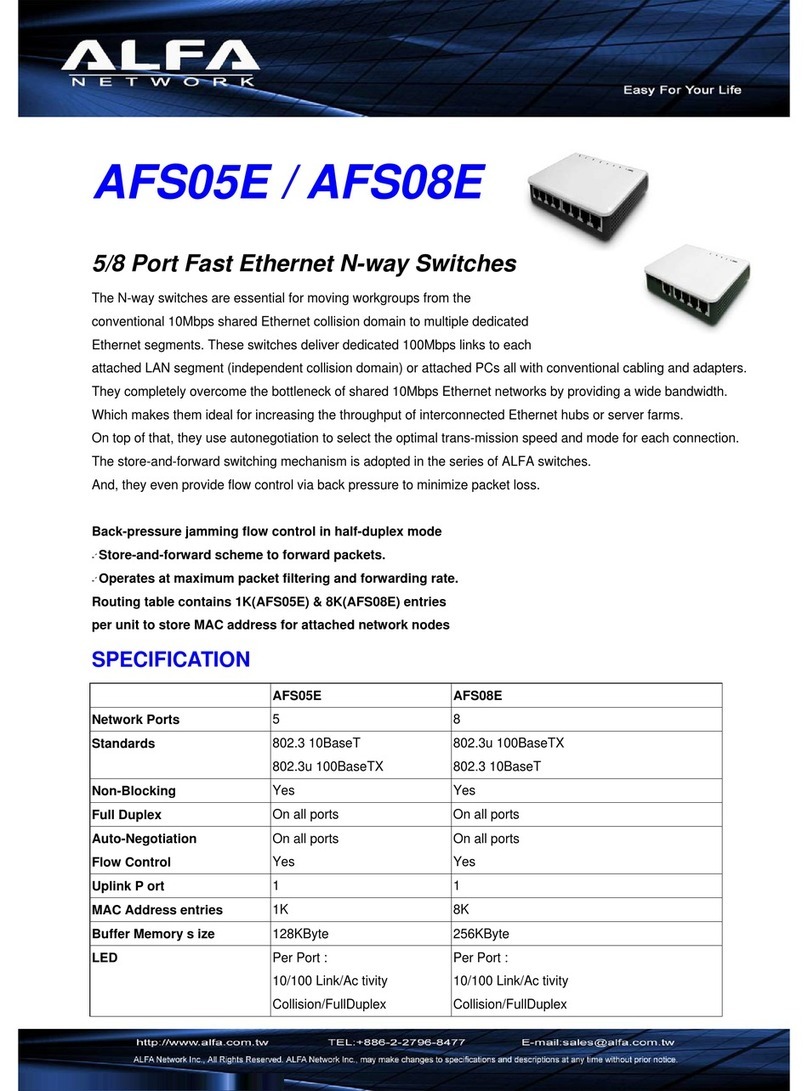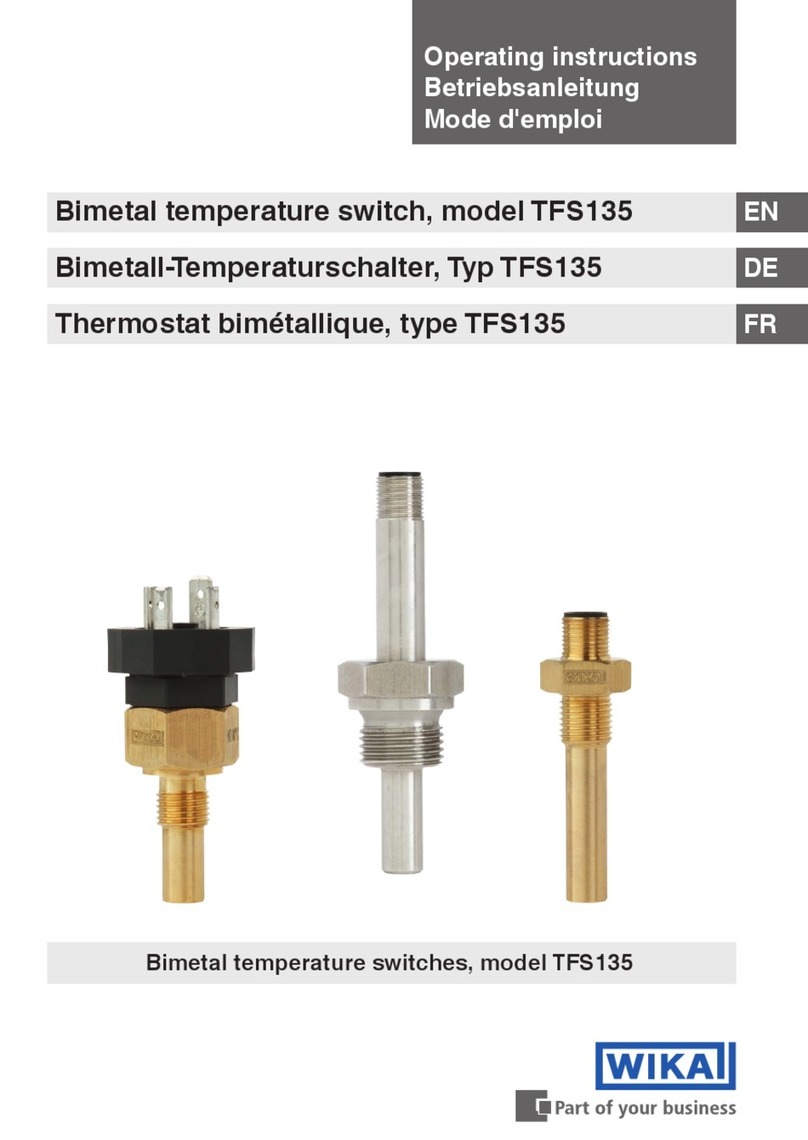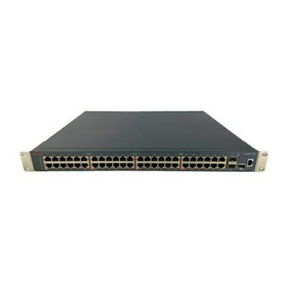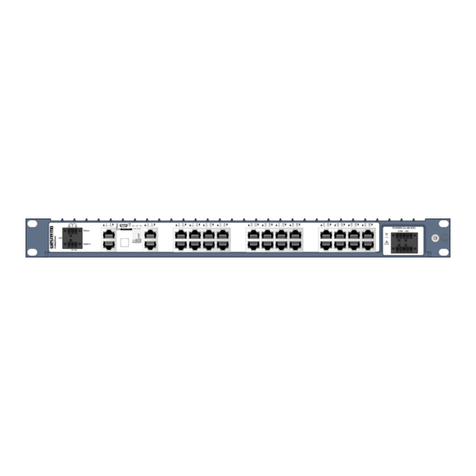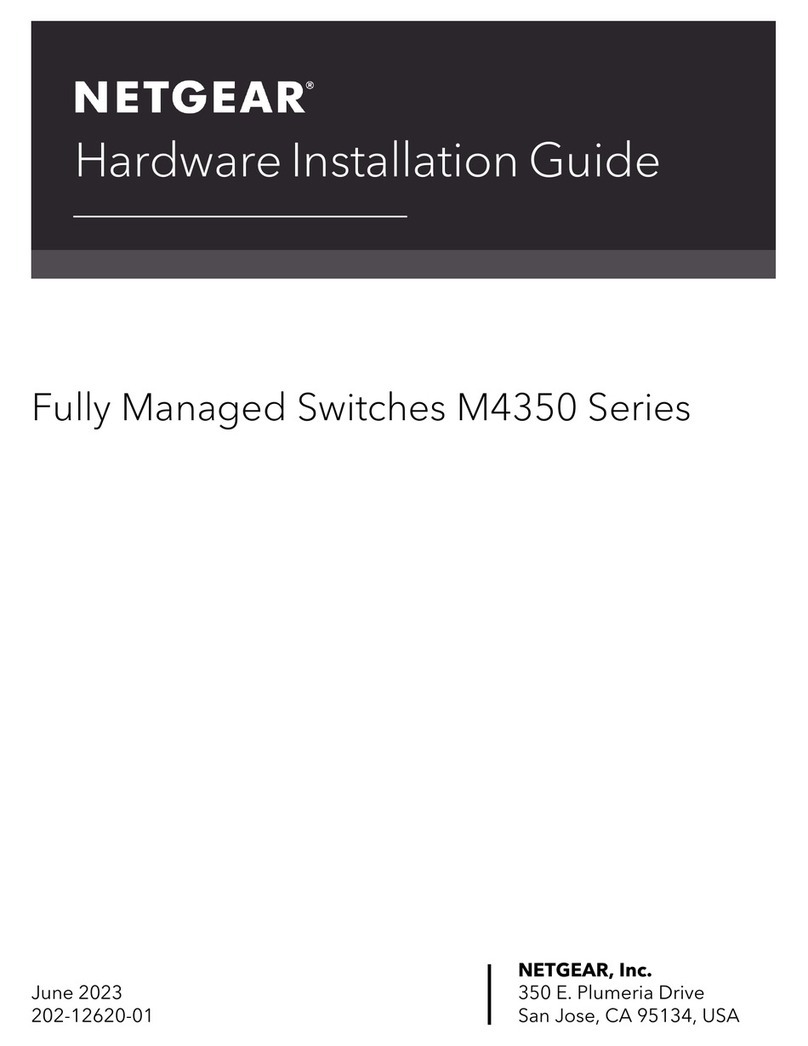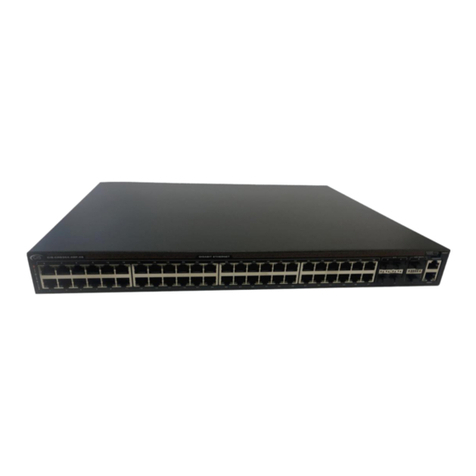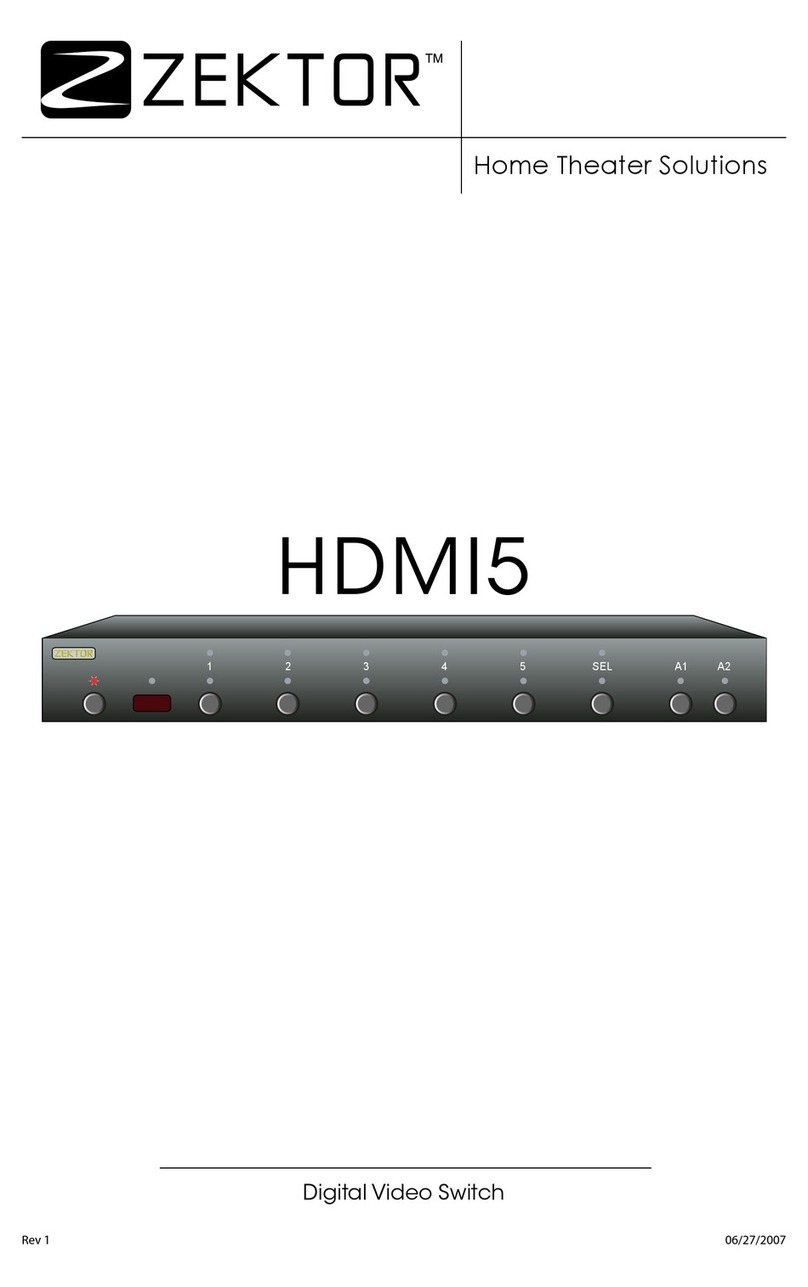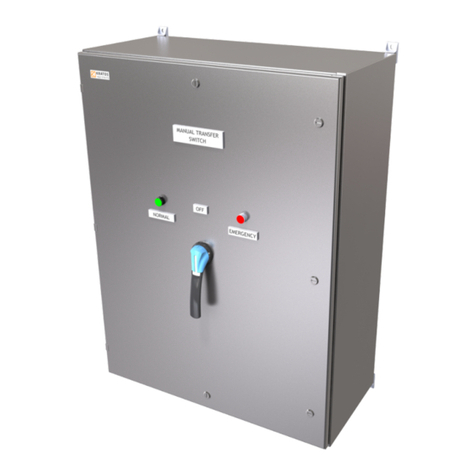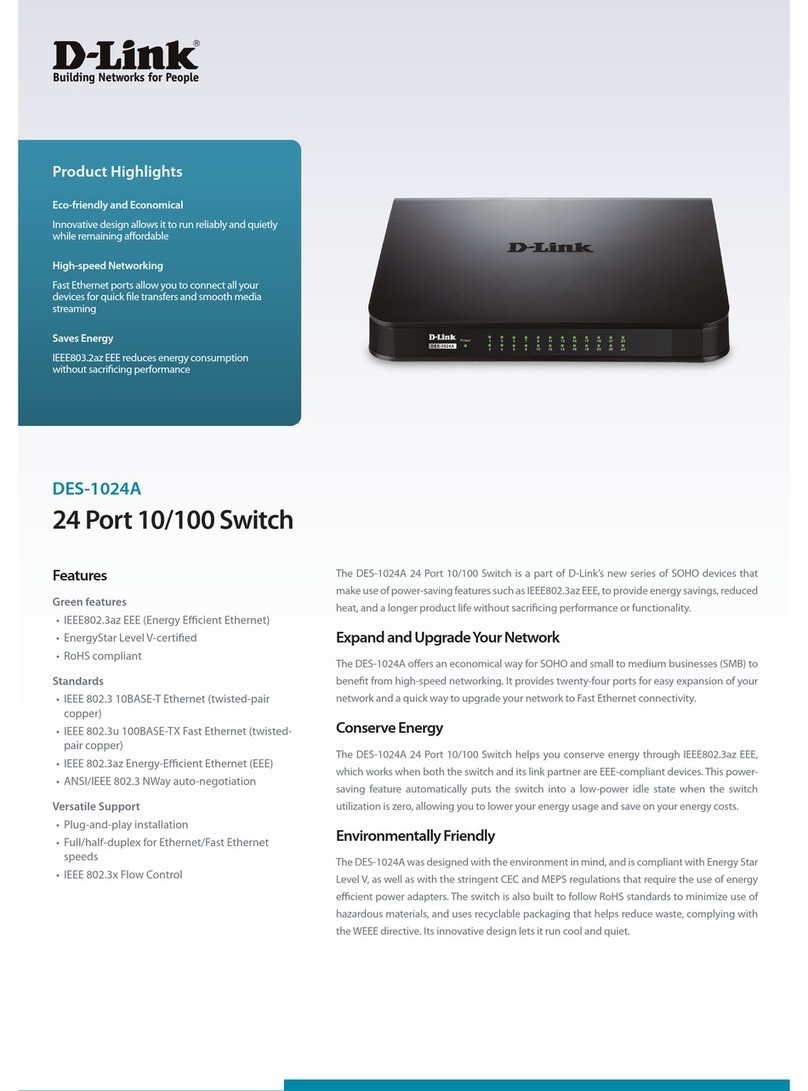IDEC HS1L Series User manual

B-1907-1(0)
INSTRUCTION SHEET - HS1L Series Solenoid Type Safety Switch
( 1 / 6 )
2016.08
2Specifications and Ratings
1Type
Type Nos. in [ ] are not supplied as
standard.Contact IDEC if required.
Solenoid voltage / Lock Mechanism
4 : 24V DC / Spring Lock
7Y : 24V DC / Solenid Lock
LED voltage
4 : DC24V
[0] : Without LED
Conduit Type
blank : G1/2
P : PG13 5
M : M20
Body Color
R : Red/Black
Indicator Color
G : Green
R : Red
HS1L-R44KMSRP-G
Actuator Tensile Strength
when Locked
MS : 3,000N
Mnual unlock key
[blank] : Without Manual Unlock Key
K : With Manual Unlock Key
R : 1NC + 1NC 1NC, 1NO 2NC
DQ : 1NC + 1NC 1NO 1NO
1NC + 1NC
DT : 1NC + 1NC 1NC 1NC
1NC + 1NC
[VR] : 2NC,1NO 3NC
[VQ] : 2NC,1NO 2NC,1NO
[VT] : 3NC 3NC
Main
circuit Door monitor
circuit Lock monitor
circuit
EN ISO / ISO14119
IEC60947-5-1, EN60947-5-1
GS-ET-19, UL508, CSA C22.2 No.14
IEC60204-1/EN60204-1
Machinery Directive, Low Voltage Directive
-20 to +55°C (no freezing)
45 to 85%(no condensation)
-40 to +80°C (no freezing)
3
10A
Applicable Standards
Standards for Use
Applicable Direc ives
Operating
Condition
Thermal Current ‹Ith›
Contact Ratings
(Reference Values)
‹Ue , Ie›
Operating Temperature
Operating Humidity
Storage
Pollution Degree
Resistive load(AC-12)
Induc ive load(AC-15)
Resistive load(DC-12)
Induc ive load(DC-13)
DC
30V 125V 250V
10A 10A 6A
Class II (IEC61140) *1
900 operations/hour
0.05 to 1.0 m/s
11mm min.
50N min.
50mΩmax. (Initial value)
250V, 10A fast acting type fuse*5
24VDC 100%ED
200mA (Initial value)
Rated Voltage × 85% max. (at 20°C)
Rated Voltage × 10% min. (at 20°C)
Approx. 5W
24VDC
10mA
LED
R(Red), G(Green) (Φ12 Lens)
Approx. 450g
Class of Protection
Operating Frequency
Operating Speed
Actuator Tensile Strength
when Locked
Direct Opening Travel
Direct Opening Force
Contact Resistance
Short-circuit protective device
100A (250V)
Conditional short circuit current
Rated Operating Voltage
Rated Current
Turn ON Voltage
Turn OFF Voltage
Rated Power Consumption
Rated Operating Voltage
Rated Current
Light Source
Lens Color
Weight
AC
Temperature
10A 5A 3A
8A 2.2A 1.1A
4A 1.1A 0.6A
Mechanical Durability
100,000 operations min.
(900 operations / hour, Rated Load)
1,000,000 operations min.
(900 operations / hour, 24V AC/DC 0.1A Resistive Load)
GB14048.5
4kV (Between ground and LED,solenoid circuit : 1.5kV)
Impulse withstand voltage ‹Uimp›
300V (Between ground and LED,solenoid circuit : 30V)
Rated insulation voltage ‹Ui›
1,000,000 operations min. (GS-ET-19)
Electrical Durability
B10d 2,000,000
(EN ISO 13849-1 Annex C Table C.1)
IP67 (IEC60529)
Degree of Protection
2000m maximum
Altitude
Interlocking device Type
/ the level of coded
Type 2 Interlocking device
/ low level coded actuator (EN ISO / ISO14119)
Shock Resistance
Vibration Resistance
Damage Limits: 1,000m/s2
Operating Extremes:10 to 55 Hz, half amplitude 0.35mm
Damage Limits: 30 Hz, half amplitude 1.5mm
Solenoid
Indicator
Fzh=3,000N minimum
F1max.=3,900N minimum (GS-ET-19) *2, *3, *4
*1 Basic insulation of 4kV impulse withstand voltage is ensured between different
contact circuits and between contact circuits and LED or solenoid in the enclosure.
When both SELV (safety extra low voltage) or PELV (protective extra low voltage)
circuits and other circuits (such as 230V AC circuits) are used for the solenoid
power and contact circuits at the same time, the SELV or PELV requirements are
not met any more.
*2 See item 8 Dimensions.
*3 The actuator locking strength is rated at 3,000N of static load. Do not apply a load
higher than the rated value. When a higher load is expected to work on the
actuator, provide an addi ional system consisting of another safety switch without
lock (such as the HS5D safety switch) or a sensor to detect door opening and stop
the machine.
*4 F1max. is maximum force. The actuator’s guard-locking force Fzh is calculated in
accodance with GS-ET-19:
*5 Make sure that a fast acting fuse for short-circuit protection trips before overheating
of the wires.
Ratings approved by safety agencies
(1)TÜV rating
AC-15 250V, 3A
DC-13 30V, 4A
(2)UL, c-UL rating
A300 3A, 250V ac, Pilot Duty
4A, 30V dc, Pilot Duty
(3) CCC rating
3A, 250VAC
4A, 30VDC
Circuit Code
Thank you for purchasing this IDEC product. Confirm that the delivered product is
what you have ordered. Read this instruction sheet to make sure of correct operation.
In this operation instruction sheet, safety precautions are categorized in order of
importance to Warning and Caution :
Warning notices are used to emphasize that improper operation may cause severe
personal injury or death.
Caution notices are used where inattention might cause personal injury or damage to
equipment.
INSTRUCTION SHEET
Original Instructions
Solenoid Type Safety Switch
HS1L Series
SAFETY PRECAUTIONS
CAUTION
WARNING
CAUTION
Solenoid lock type
•
This safety switch is designed to lock the actuator while the solenoid is energized
and to release it when deenergized.
•
When the power to the solenoid is interrupted by accident, such as disconnection,
the lock is released before a machine stops ompletely. Then, the worker may be
exposed to hazards.
•
This safety switch can be used only for limited applica ions which do not especially
need to be locked for safety.
Fzh
=
maximum force (F1max.)
Safety coefficient (=1.3)

B-1907-1(0)
INSTRUCTION SHEET - HS1L Series Solenoid Type Safety Switch
( 2 / 6 )
2016.08
3Mounting Examples
• Install the interlock switch on the immovable machine or guard, and install the
actuator on the movable door. Do not install both interlock switch and actuator on
themovable door, otherwise the angle of insertion of the actuator to the safety switch
may become inappropriate, and failure will occur.
• As shown below, the mounting reference position of the actuator inserted into the
safety switch is the actuator cover or stop film touches he safety switch lightly. (After
mounting the actuator, remove the actuator cover or stop film from the actuator.)
• Mounting tolerance of the actuator is 0.5mm
from the center of the actuator to up, down,
right, and, left.
• Make sure the actuator can be inserted into
the entry slot without any issue.
• Actuator can move 3.3mm (HS9Z-A1S and
-A2S) / 2.6mm (HS9Z-A3S) from the mounting
reference position without affecting the contact
operation.
• When closing the door, the actuator is inserted
and locked within approx. 3.8mm (HS9Z-A1S
and -A2S) / 3.3mm (HS9Z-A3S) from the
mounting reference position.
• Break a desired knockout to mount a connector using a
hammer and a screwdriver.
• Remove the connector lock nut from inside the safety
switch before breaking the knockout to open a connector
hole.
• When breaking the knockout to open a connector hole, be
careful not to damage the internal contact block.
Note : Cracks or burrs on the connector hole will degrade the
waterproof characteristics.
(Examples of Mounting on Hinged Doors)
Door
HS1L
Safety Switch
HS9Z-A1S
Actuator
Lock
Door Stop
Hinged
Door
HS1L
Safety Switch Latch
HS9Z-A2S
Actuator HS9Z-A1S
Actuator
(Examples of Mounting on Sliding Doors)
• L-shaped actuator : HS9Z-A2S
• Adjustable actuator : HS9Z-A3S
When using the safety switch for a hinged door, the minimum radius of the applicable
door is shown in the following figures.
Minimum Radius
270mm
Door Hinge
Minimum Radius
450mm
Door Hinge
When the center of the hinged door is
on he extension line of the contact
surface of actuator and safety switch.
( )
Minimum Radius
510mm
Door Hinge
Minimum Radius
840mm
Door Hinge
When the center of the hinged
door is on the extension line of the
actuator moun ing surfase.
( )
Minimum
Radius
80mm
Door Hinge
Minimum
Radius
50mm
Door Hinge
When the center of the hinged door is on
the extension line of the contact surface
of actuator and safety switch.
( )
When the center of the hinged door is
on the extension line of the actuator
mounting surfase.
( )
Minimum Radius of Hinged Door
Recommended Screw Tightening Torque
Opening the Connector Hole
• Using the angle adjusting screw (M3 hexagon
socket head screw), the actuator angle can be
adjusted up to 20°.
• The larger the actuator angle, the smaller the appli-
cable radius of the door swing. After installing the
actuator, open the door. Then adjust the actuator
angle so that the actuator enters the entry slot of
the safety switch properly.
• After adjusting the actuator angle, apply loctite or the like on the adjusting screw to
prevent loosening.
Adjusting the Angle Adjustable Actuator (HS9Z-A3S)
Actuator Mounting Reference Position
Actuator Mounting Tolerance
HS9Z-A1S
Actuator
Cover
Safety Switch
Door Stop
Door Stop Actuator
Cover
Safety SwitchSafety Switch
HS9Z-A2S HS9Z-A3S
Stop film
≤3.3/ 2.6mm
+
Deviation of Deviation of
actuator position
door position
±0.5mm
±0.5mm
Center
Center
Safety
Switch
HS9Z-A1S
and -A2S HS9Z-A3S
2.6mm
3.3mm
HS9Z-A1S
and -A2S HS9Z-A3S
Approx.
3.8mm
Approx.
3.3mm
For mounting the safety switch (M5 screw) *6
For mounting the actuator
HS9Z-A1S, HS9Z-A2S (M5 screw) *6 *7
HS9Z-A3S (M6 screw)
For mounting the lid (M4)
Terminal screw (M3)
Connector
Angle adjusting screw of HS9Z-A3S
(M3 Hexagon Socket Head Screw)
Screw Tightening Torque
3.2 to 3.8 N•m
2.7 to 3.3 N•m
4.5 to 5.5 N•m
0.9 to 1.1 N•m
0.6 to 0.8 N•m
2.7 to 3.3 N•m
0.8 N•m
20°
Angle adjusting
screw
CAUTION
The figures shown above are based on the condition that the actuator enters and
exits the actuator entry slot smoothly when the door is closed or opened. Since
there may be deviation or dislocation of the hinged door, make sure of correct
operation in the actual application before installation.
CAUTION
*6 When the torque is not enough to recommended screw tightening torque, make
sure that the screw do not become loose by using adhesive sealants etc. to
keep right operation and mounting positioning.
*7 When rubber cushions (and spacers) are not used,
use M6 screws and tighten to a torque of 4.5 to 5.5
N•m. Rubber Cushions

B-1907-1(0)
INSTRUCTION SHEET - HS1L Series Solenoid Type Safety Switch
( 3 / 6 )
2016.08
4Precautions for Operation
Installation
• Do not apply an excessive shock to the safety switch when opening or closing the
door. A shock to the safety switch exceeding 1,000 m/s2may cause failure.
• Provide a door guide, and ensure that force is applied on the safety switch only in
the actuator insertion direction.
• Do not pull the actuator while it is locked. Also, regardless of
door types, do not use the safety switch as a door lock. Install
a separate lock as shown in section 3.
• When opening the safety switch lid to wire, open the lid
only. (See the figure on the right.) Never remove other screws,
otherwise the safety switch may be damaged.
• The safety switch cover can be only removed or installed with
the special L-shaped wrench supplied with the safety switch.
• Entry of foreign objects in the actuator entry slot may affect the
mechanism of the safety switch and cause a breakdown. If the
operating atmosphere is contaminated, use a protective cover
to prevent the entry of foreign objects into the safety switch
through the actuator entry slots.
• Avoid foreign objects such as dust, liquid and oil from entering
the safety switch while connecting a conduit or wiring.
• Make sure to install the product in a place where it cannot be
damaged. Make sure to conduct a proper risk assessment
evaluation before using the product, and use a shield or a cover to protect the prod-
uct if need be.
• While the solenoid is energized , the switch temperature rises
approximately 40° C above he ambient temperature (to approximate-
ly 95°C while the ambient temperature is 55°C). Keep hands off to
prevent burns. Use heat-resistant wire when the solenoid touches
wires.
• Use only the designated actuator for the HS1L. Other actuators will cause a break-
down of the safety switch.
• Solenoid has polarity. Besure to wire correctly.
A
L-shaped wrench
attached to the
safety switch
Type : HS9Z-T1
• To ensure safety, make sure that the power is
turned off before opening or closing the cover.
• Do not touch the part B (shown in the figure on the
bellow) with tools or fingers when opening the
interlock switch cover. Otherwise the interlock
switch may be damaged.
• Close the cover only as described below, otherwise
failure of interlock switch will be caused.
(Method)
1.Confirm that the manual unlock state on the
cover is in "normal state".
2. Open the door (actuator is removed).
3. Close the cover, and tighten the screws to the
appropriate torque.
Opening / Closing the Cover (Type : HS1L-*K)
normal
state
UNLOCK
2.Open he door
(actuator is removed)
B
1.
WARNING
• Turn off the power to the safety switch before starting installation, removal, wiring,
maintenance, and inspection on the safety switch. Failure to turn power off may
cause electrical shocks or fire hazard.
• Do not disassemble or modify the switch. Also do not attempt to disable the
interlock switch function, otherwise a breakdown or an accident will result.
• Use wires of a proper size to meet voltage and current requirements. Tighten the
terminal screws to a recommended tightening torque of 0.9 to 1.1N•m. Loose
terminal screws will cause unexpected heating and fire hazard during operation.
(Type HS1L-□4)
The HS1L allows manual unlocking of the key to precheck door operation before wiring
or turning on power, as well as for emergency use such as a power failure.
(Type HS1L-□7Y)
In case the actuator is not unlocked when the solenoid is deenergized, the actuator
can be unlocked manually.
For Manual Unlocking
• HS1L wi h manual unlock key:
To change the normal position to the
manual unlocking position as shown on the
right, turn the key fully (90 degrees) using
the red plastic key included with the safety
switch.
Using the safety switch with the key being
not fully turned (less than 90 degrees) may
cause damage to the safety switch or errors.
(note: when manually unlocked, the safety switch will keep the main circuit and the
lock monitor circuit disconnected and the door unlocked.)
Do not attach the key to the safety switch intentionally (the key is designed to fall off
when the operator's hand is off the key).
In such case, safety standards become unapplied because the safety switch can be
always unlocked during machine operation, and therefore will give hazardous condi-
tions to workers.
• HS1L wi hout manual unlock key
Remove the screw at the side of the safety switch using the
wrench for mounting the HS1L lid. Push the lever inside the
safety switch toward the pilot light using a small screwdriver
un il he actuator is unlocked. See the figure on the right.
• Common
Insert a small screwdriver form the hole of the reverse side of
the safety switch. Push the pin inside the safety switch toward
the pilot light using a small screwdriver until the actuator is
unlocked. See the figure on the right.
A hole for the lever should be opened on the mounting panel.
When opening the hole, apply proper protection against water
and other foreign objects.
(Unlocking Method)
Manual
Unlocking
Position
Normal
Position
UNLOCK UNLOCK
Screwdriver
A
CAUTION
• Before manually unlocking the safety switch, make sure the machine has come to
a complete stop. Manual unlocking during operation may unlock the safety switch
before the machine stops, and the function of safety switch is lost.
• While the solenoid is energized, do not unlock the actuator manually (Solenoid
lock type).
CAUTION
• HS1L Series Safety Switches are Type 2 low-level coded interlocking devices (EN
ISO / ISO14119). The following system installation & mounting instructions are EN
ISO / ISO14119 requirements to prevent function failure from the interlock switch.
1. Using permanent fixing methods (e.g. welding, rivets, special screws...etc) to
prevent dismantling or de-positioning of the interlock device. However, perma-
nent fixing methods are not an adequate solution if you expect the interlock
device to fail during the machinery lifetime, or if you need to replace the prod-
uct in quick manner. In these situations, other measures (see 2.) should be put
in place to reduce the risks of function failure.
2. At least one of the following measures should be applied to prevent function
failure.
(1) Mounting the interlock device in a place out of reach from workers
(2) Using shielding protection to prevent physical obstruction of the device
(3) Mounting the interlock device in a hidden position
(4) Integrate status monitoring & cycling testing of the device to the control
system to prevent product failure.
• Regardless of door types, do not use the safety switdh as a door stop. Install a
mechanical door stop at the end of the door to protect the safety switch against an
excessive force.
• Do not instal the actuator in the location where the human body may come into
contact.
Otherewise injury may occur.
• Pay attention to the management of spare actuator. Safety function of safety
switch will be lost in case the spare actuator is inserted into the safety switch.
Ensure that the actuator is firmly fastened to the door (welding, rivet, special
screw) in the appropriate location, so that the actuator cannot be removed easily.
• Do not cut or remodel the actuator, otherwise failure will occur.
• Performance Level according to EN ISO 13849-1 is reduced with series connected
safety components due to decreased fault recognition.
• The insulation of the cable has to withstand environmental influences.
• The overall concept of control system, into which the safety components has been
integrated, must be validated in accordance with EN ISO 13849-2.

B-1907-1(0)
INSTRUCTION SHEET - HS1L Series Solenoid Type Safety Switch
( 4 / 6 )
2016.08
Contact Configuration and Operating Characteristic
Operation Cycle
5Contact Operation
• Contact operation is based on the condition that the actuator is inserted into the
center of the safety switch slot.
• Contact operation shows the HS9Z-A1S, A2S, A3S actuator.
• Use main circuit or monitor circuit with for the input to safety circuit.
6Wiring
Wire Stripping
Length: L2(mm)
Wire Length:
L1(mm)
Through Conduit Port
I
95±2
85±2
50±2
65±2
55±2
45±2
50±2
60±2
II
45±2
35±2
60±2
95±2
85±2
75±2
45±2
40±2
Wire Length inside the Safety Switch
7±1
11
21
32/34
42
52
62/64
A1
A2
Screw
Terminal
No.
X1
X2
70±2 35±2
80±2 35±2
35±2 60±2
61/63
45±2 70±2
51
75±2 35±2
31/33
60±2 70±2
22
* Do not remove the wires of the terminals
12-41 and 22-51, because these terminals
are interconnected in factory for safety
circuit inputs. Use terminals 11-42 or 21-52
for safety circuit inputs.
II
I
X2 X1 A2 A1
31/33
21
11
32/34
22
12
61/63
51
41
62/64
52
42
Safety Switch Connector
L1L2
Applicable Crimping Terminal
Recommended Wire Core Size
: 0.5 to 1.5 mm
• N0.5-3/ FN0.5 (made by JST) :Applicable wire core size 0.2 to 0.5mm2
• N1.25-MS3 (made by JST) : Applicable wire core size 0.25 to 1.65mm2
• V1.25-YS3A (made by JST) : Applicable wire core size 0.25 to 1.65mm2
4.2mm min.
L1
Φ3.2mm min.
6.4mm max.
Insulation Tube
Wire
Approx.4mm
Crimping
Terminal
Note: Make sure to use an insulation tube on the
crimping terminal.
Wire Stripping Length:
L2(mm)
Wire Length:
L1(mm)
Through Conduit Port
95±2
85±2
50±2
65±2
55±2
45±2
50±2
60±2
45±2
35±2
60±2
95±2
85±2
75±2
45±2
40±2
7±1
11
21
32/34
42
52
62/64
A1
A2
Screw
Terminal
No.
X1
X2
70±2 35±2
80±2 35±2
35±2 60±2
61/63
45±2 70±2
51
75±2 35±2
31/33
60±2 70±2
22
55±2 80±2
41
80±2 80±2
12
I II
I
II
X2 X1 A2 A1
31/33
21
11
32/34
22
12
61/63
51
41
62/64
52
42
11-42
61-62
31-32
21-52
11-42
21-52
33-34
63-64
21-22
11-42
33-34
51-52
61 62
31 32
21 22
63 64
3433
5251
2221
33 34
2221
41 421211
11 12 4241
41 421211
A2 A1
HS1L-R□
HS1L-DQ□
HS1L-DT□
Main Circuit :
Monitor Circuit :
Monitor Circuit :
Monitor Circuit :
Monitor Circuit :
Monitor Circuit :
Main Circuit :
Main Circuit :
Main Circuit :
Main Circuit :
Monitor Circuit :
Monitor Circuit :
61-62
6261
5251
51 52
Monitor Circuit :
X2 X1 *8
11-12
41-42
31-32
21-22
11-12
21-22
33-34
41-42
21-22
11-12
33-34
51-52
61 62
31 32
21 22
63 64
3433
5251
2221
33 34
2221
41 42
1211
11 12
4241
41 42
1211
HS1L-VR□
HS1L-VQ□
HS1L-VT□
Monitor Circuit :
Monitor Circuit :
Monitor Circuit :
Monitor Circuit :
Monitor Circuit :
Monitor Circuit :
Monitor Circuit :
Monitor Circuit :
Monitor Circuit :
Monitor Circuit :
Monitor Circuit :
Monitor Circuit :
61-62
6261
5251
51 52
Monitor Circuit :
Monitor Circuit :
41-42
51-52
63-64
Monitor Circuit :
Monitor Circuit :
61-62
51-52
Monitor Circuit :
Monitor Circuit :
Contact Closed
Contact Open
Door
monitor Lock
monitorIndicator Approx.4 2 (Lock)
0
(Actuator Mounting Reference Position)
(Travel : mm)
Operating Characteristic (reference)
Approx.
30.0
Approx.
10 0
(Actuator
Pulled Out)
(Actuator
Completely Inserted)
Contact Configuration*9
Approx.
7 0
Type
(
-
)(+)
(+)(
-
)
Door States
Manual Unlock Key
Main Circuit 11-42
21-52
Monitor Circuit 21-22
31-32
Monitor Circuit 33-34
Monitor Circuit 51-52
61-62
Monitor Circuit 63-64
Spring Lock Type
(HS1L-□4)
Solenoid Power A1-A2
Solenoid Lock Type
(HS1L-□7Y)
Solenoid Power A1-A2
•Door is locked.
•The machine can
be operated.
Open
Open
Closed
•The machine can
not be operated.
Off / On *11
Closed
Closed
Open
•Door is unlocked.
•The machine can
not be operated.
Closed
Open
Closed
•Door is unlocked.
•The machine can
not be operated.
Off*10 *11
Closed
Open
to unlock position
Turn the key
Closed
On
Off
Closed
Closed
Closed
-
Off
On
Open
Closed
Open
-
Off / On
Open
Open
Open
-
Off
Open
Closed
Open
CAUTION
*8 This locking monitoring marking has been newly described in section 9.2.1 of
EN ISO/ ISO14119.It indicates that any devices with this marking meet the
following EN ISO/ ISO 14119 requirements:
- General (- General requirements for guard locking devices) (Section 5.7.1) *
- Locking monitoring (- Locking monitoring for guard locking devices) (Section
5.7.2.2)
When a lock monitor circuit (contact) has the locking monitoring marking, it
means that one circuit (contact) can monitor the position and the locking
function of the protective door.(The locking monitoring circuit (contact) turns
ON only when the protective door is closed and locked )
*note Both types of HS1L safety switches - spring lock type switches and solenoid
lock type switches - have obtained the locking monitoring cer ification marking.
Based on risk assessment results, solenoid lock type switches can be used
only for limited applications which do not especially need to be locked for
safety.
*9 The Actuator is inserted , and HS1L is locked.
CAUTION
*10 Do not attempt manual unlocking when the solenoid is energized.
*11 Do not energize the solenoid for a long time while the door is open or when
the door is unlocked manually.
(HS1L-□)
Door States
Manual Unlock Key
Monitor Circuit 11-12
21-22
31-32
Monitor Circuit 33-34
Monitor Circuit 41-42
51-52
61-62
Monitor Circuit 63-64
Spring Lock Type (HS1L-□4)
Solenoid Power A1-A2
Solenoid Lock Type (HS1L-□7Y)
Solenoid Power A1-A2
•Door is locked.
•The machine can
be operated.
Open
Closed
Open
Closed
Closed
•The machine can
not be operated.
*11
Off / On
Closed
Open
Closed
Open
Open
•Door is unlocked.
•The machine can
not be operated.
Closed
Open
Open
Closed
Closed
•Door is unlocked.
•The machine can
not be operated.
*10 *11
Off
Closed
Open
Open
Closed
to unlock position
Turn the key
Closed
On
Off
-
Off
On
-
Off / On
-
Off
(HS1L-V□)
(HS1L-V□)
(HS1L-□)

B-1907-1(0)
INSTRUCTION SHEET - HS1L Series Solenoid Type Safety Switch
( 5 / 6 )
2016.08
7
Example of wiring Diagram realizing Safety Category
DC24V
S3
F1
K4
K3
DC0V
A1(
-
)
A2(+)
52
S1
12
11
HR1S-AF Safety relay module
13
14
ESC
K4
K3 S2
51
42
41
22
21
S33 S34 13 23A1
S11 S22
14 24A2
S12S21
34
33
62
61
DC24V
S3
F1
K4
K3
DC0V
HR1S-AF Safety relay module
13
14
ESC
K4
K3 S2
S33 S34 13 23A1
S11 S22
14 24
S12S21
S4
1
2
A1(
-
)
A2(+)
52
S1
12
11
51
42
41
22
21
A2
34
33
62
61
L1(+)
N(−)
L1(+)
N(−)
One of the example of
the circuit ; Safety
relay module, HR1S-AF
series manufactured
by IDEC CORPORATION
Output Circuit Output Circuit
One of the example of
the circuit ; Safety
relay module, HR1S-AF
series manufactured
by IDEC CORPORATION
Used as
open/close
monitor of guard
Used as
open/close
monitor of guard
S1: HS1L-R4 Safety Switch with Solenoid
S2: Starting Switch (HW Series Momentary)
S3: Unlocking Enabling Switch
S4: Safety limit Switch
ESC: Outside start condition
K3, 4: Safety Contactor
F1: Outside fuse of safety relay module at power supply line
Note: Use the monitoring device(Safety relay module) provided the capavility to
detect a cross short circuit. The insulation of the cable has to withstand
environmental influences. If a control device o her than the one shown in the
draft is used, the used control device has to be equipped with a cross short
circuit monitor.
Guard Open Guard Open
HS9Z-A1S Actuator HS9Z-A1S Actuator
HS1L-R4
Safety Switch with Solenoid
HS1L-R4
Safety Switch with Solenoid
Example of a circuit diagram for Safety Category 4
(attainable PL = e)
Example of a circuit diagram for Safety Category 3
(attainable PL = d)
(Condition 1: To apply the fault exclusion of mechanical structural parts including the actuator
→ Make sure to use the product within he product specification range described in his
manual and the version of the manual provided wi h the product.)
(Condition 2: Documentation of the reason for the machine/equipment manufacturer to have
applied the fault exclusion based on ISO13849-1, ISO13849-2 or IEC62061.)
Used as
lock / unlock
monitor
Used as
lock / Unlock
monitor
Applicable Connectors
Use a connector with a degree of protection IP67.
Applicable connector dimensions: See the figure
on the right.
9mm max.
Conduit Thread
30mm max.
• When using flexible conduit and metal connector
Applicable Flexible Conduit Example:
Type VF-03 (made by Nihon Flex)
Applicable Metal Connector Example:
(G1/2) Type RLC-103 (made by Nihon Flex)
(PG13.5) Type RBC-103PG13.5 (made by Nihon Flex)
(M20) Type RLC-103EC20 (made by Nihon Flex)
• When using plastic connector, metal connector and multi-core cable
(G1/2) Applicable Plastic Connector Example :
Type SCS-10□ (made by Seiwa Electric)
Applicable Metal Connector Example :
Type ALS-16□□ (made by Nihon Frex)
(PG13.5) Applicable Plastic Connector Example :
Type ST13.5(made by LAPP)
Applicable Metal Connector Example :
Type ABS-□□PG13.5(made by Nihon Flex)
(M20) Applicable Plastic Connector Example :
Type ST-M20×1.5(made by LAPP)
Applicable Metal Connector Example :
Type ALS-□□EC20(made by Nihon Flex)
Note :
Confirm the outside
diameter of the multi-core
cable, the connector type
depends on the outside
diameter of multi-core
cable.
Note :
When using ST-M20×1.5,
use with gasket GP-M
(Type No: GPM20, made
by LAPP).

B-1907-1(0)
INSTRUCTION SHEET - HS1L Series Solenoid Type Safety Switch
( 6 / 6 )
2016.08
8Dimensions (mm)
Type : HS9Z-A1S Type : HS9Z-A2S
Type : HS9Z-A3S
Actuator cover
(supplied)
Accessories dimensions
RP: Actuator mounting reference position
Safety Switch dimensions
9Precaution for Disposal
Dispose of the HS1L safety switch as an industrial waste.
http://www.idec.com
Manufacturer: IDEC CORP.
2-6-64 Nishimiyahara Yodogawa-ku, Osaka 532-0004, Japan
EU Authorized Representative:IDEC Elektrotechnik GmbH
Heselstuecken 8, D-22453 Hamburg, Germany
DECLARATION OF CONFORMITY
We, IDEC CORPORATION 2-6-64, Nishimiyahara Yodogawa-ku,Osaka 532-0004, Japan declare
under our sole responsibility that the product:
Description: Safety Switch
Model No: HS1L
to which this declaration relates is in conformity with the EC Directive on the following standard(s)
or other normative document(s). In case of alteration of the product, not agreed upon by us, this
declaration will lose its validity.
Applicable EC Directive : Low Voltage Directive (2014/35/EU)
Machinery Directive (2006/42/EC)
Applicable Standard(s) : EN 60947-5-1,GS-ET-19
Slot Plug
(Supplied)
*12 The actuator entry slot vertical to the mounting panel
*13 The actuator entry slot horizontal to the mounting panel
Note: Use the slot plug attached to the safety switch to close the unused actuator entry
slot.
Note: When the actuator entry slot vertical to the mounting panel is used : Install the
interlock switch on the panel using four mounting screws.
When the actuator entry slot horizontal to the mounting panel is used : Install the
interlock switch on the panel using three mounting screws.
21±0.5
17.5±0.5
(51.3)
11.5
(65.8)(RP)
(RP)
HS9Z-A2S
61
12.3
4-M5
screw
23.5
*33.5
26
89
HS9Z-A1S
33
88
4
104
7.5
2
49.5
51
70.3
(RP)
45.4
4
5 5
35 1.5
10
121
129
26
23.5
45
63
5
19.2
22
89
10
36
55 8
(RP)
(3.5±0.5)
(7.0±0.5)
4
5
*13
*12
40
5.4
44.5
21
22
2-M5
90°
5.1
(8)
3
17.6
43
40
(45.1)
42 6
0.8
12.3
Stopper film
2-M6
20°
(21)
33max.
2
30
5
12
18
3
R3.2
72
58
44
58
17.6
20
(supplied)
22
40
9 49.3
43
17.6
3
(8)
5.1
Φ15.0
Φ5.1
0.8
19.3
Φ15
Φ5.1
22
11 5
20.5
Safety switch Mounting Hole
Layout
* Use this mounting hole when
a strong actuator retention
force is imposed to the
actuator entry slot vertical to
the mounting panel.
Mounting Hole Layout
Mounting Hole Layout
Angle ajusting screw
(M3 hexagon socket set screw)
This manual suits for next models
6
Table of contents
Other IDEC Switch manuals
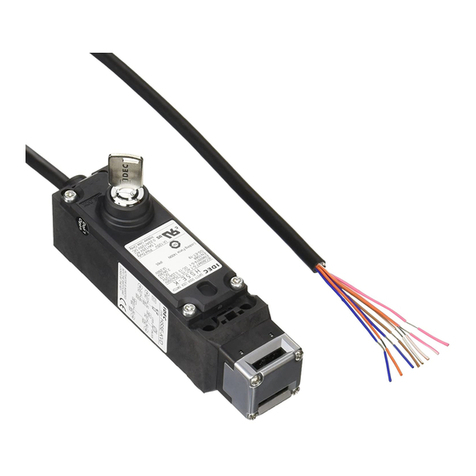
IDEC
IDEC HS5E-K User manual
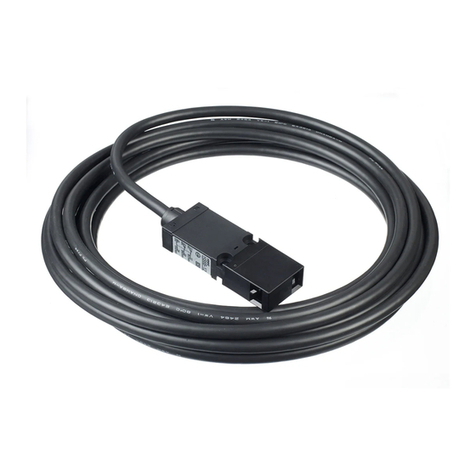
IDEC
IDEC HS6B Series User manual
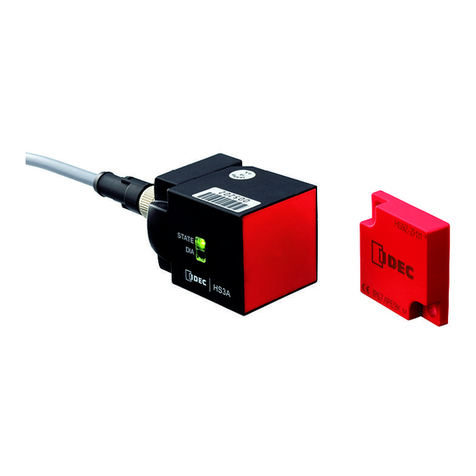
IDEC
IDEC HS3A Series User guide
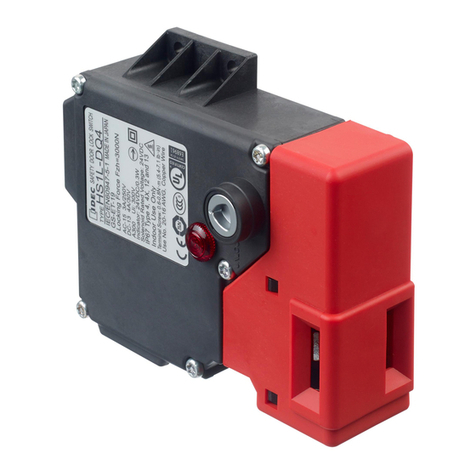
IDEC
IDEC HS1L Series User manual
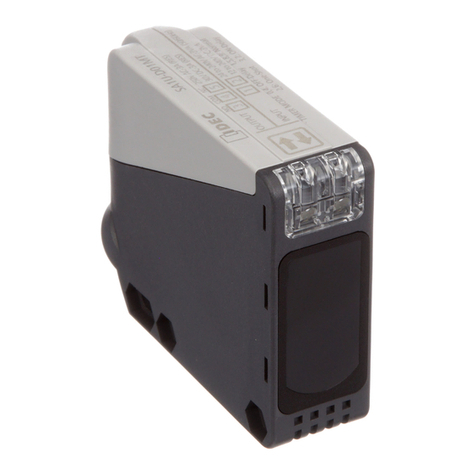
IDEC
IDEC SA1U Series User manual

IDEC
IDEC HS5E Series User manual
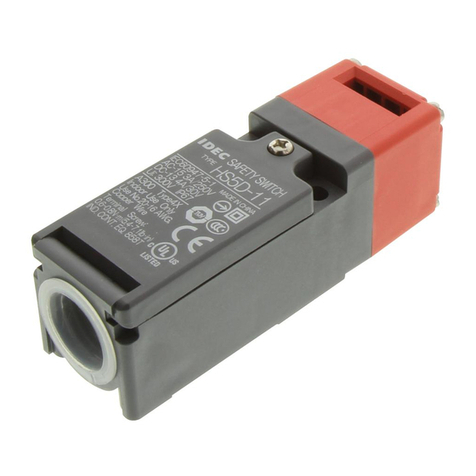
IDEC
IDEC HS5D-11 User manual
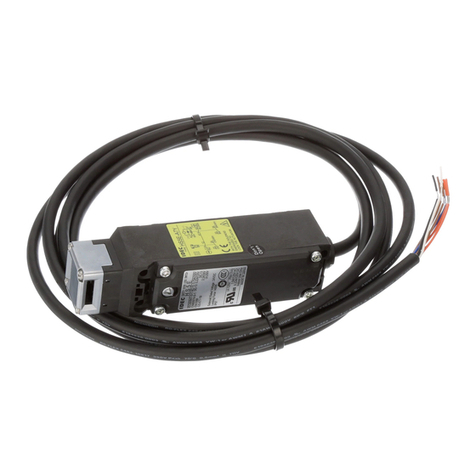
IDEC
IDEC HS5E Series User manual

IDEC
IDEC HS1C Series User manual
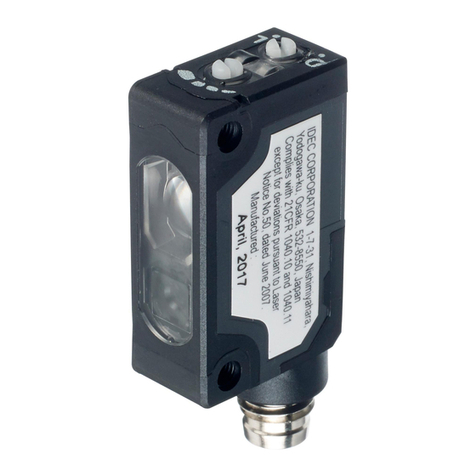
IDEC
IDEC SA1E Series User manual
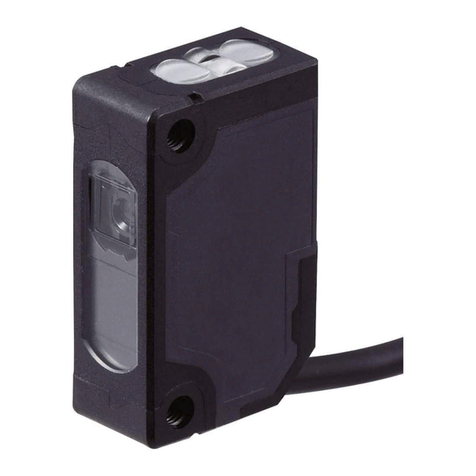
IDEC
IDEC SA1E-L Series User manual

IDEC
IDEC HS5E Series User manual
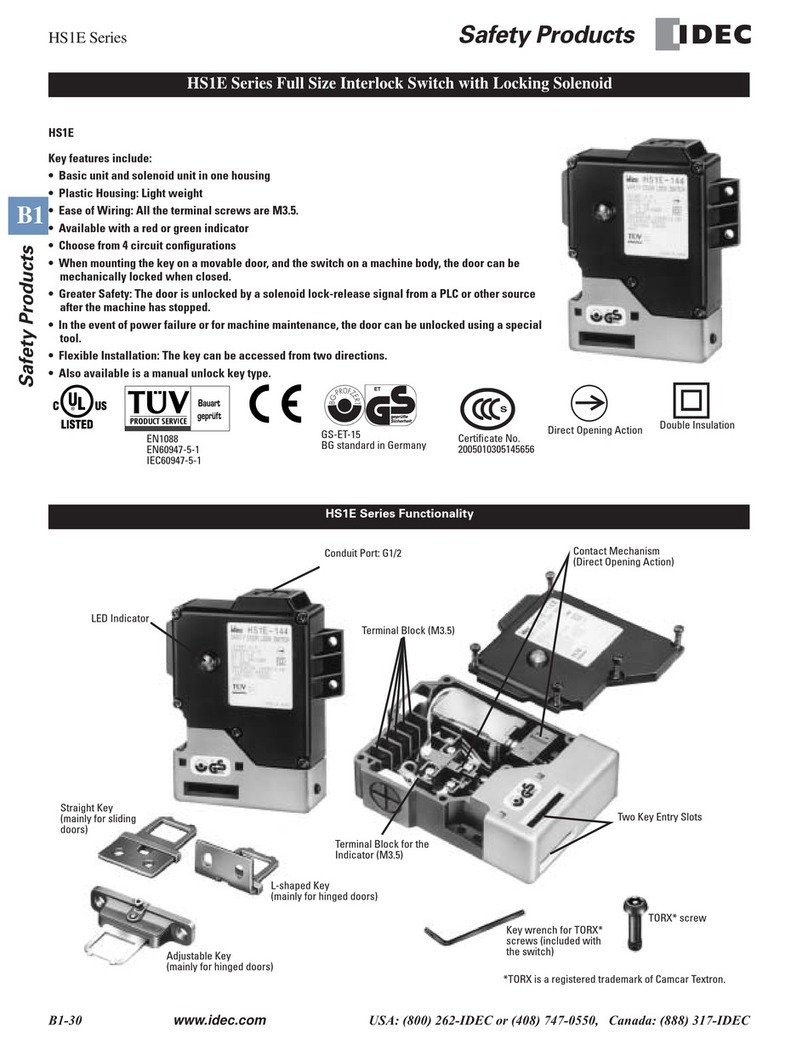
IDEC
IDEC HS1E Series User manual
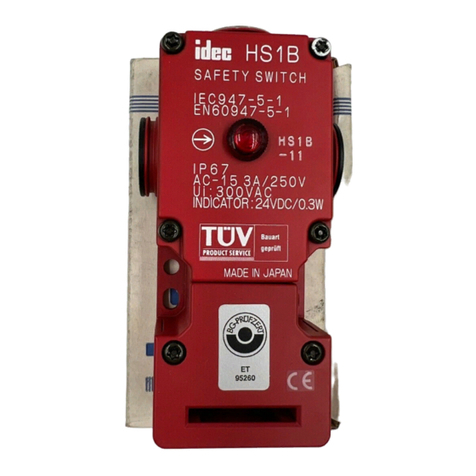
IDEC
IDEC HS1C Series User manual
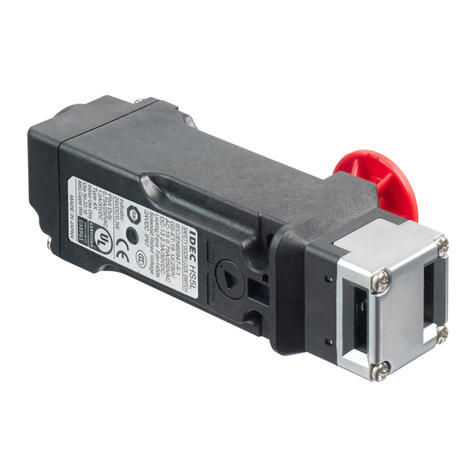
IDEC
IDEC HS5L Series User manual
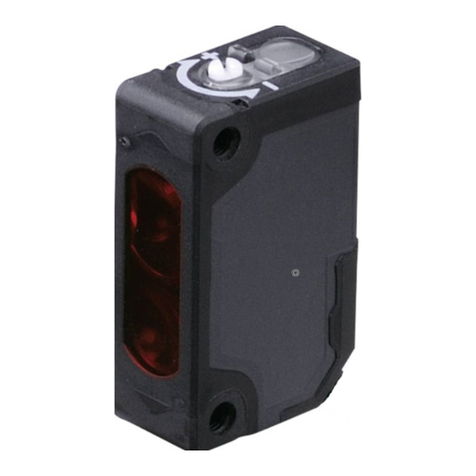
IDEC
IDEC SA1E Series User manual
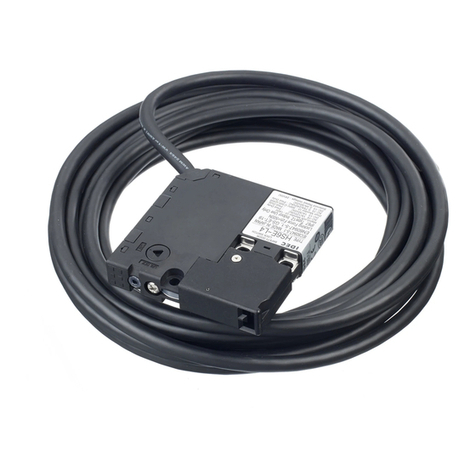
IDEC
IDEC HS6E Series User manual

IDEC
IDEC SX5E Series User manual

IDEC
IDEC HS5L Series User manual
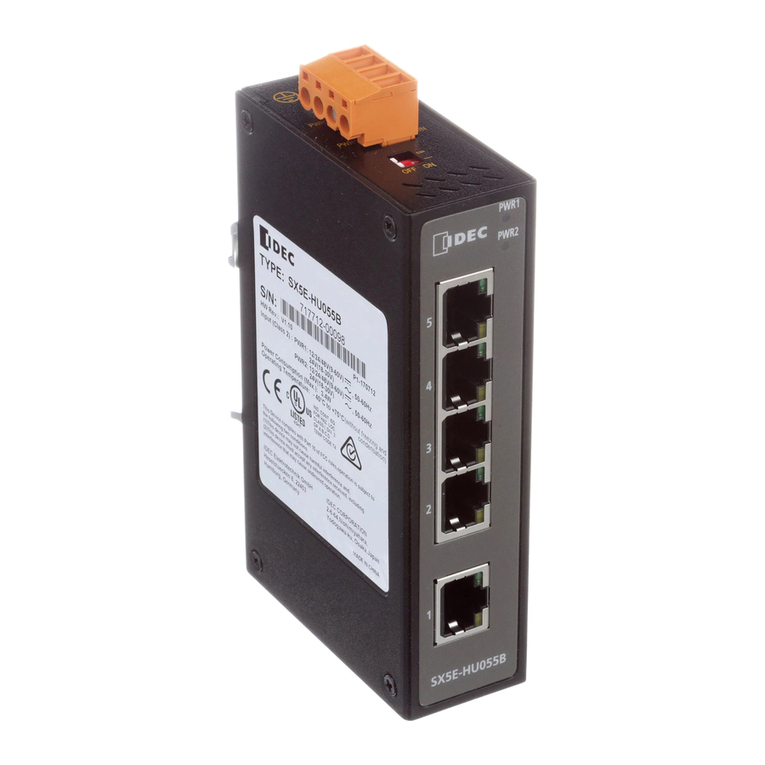
IDEC
IDEC SX5E Series User manual
